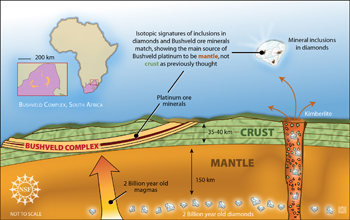News Release 08-100
Diamonds Are Forever Revealing New Insights Into Earth's Development
New research in South Africa shows possible explanation for how Bushveld platinum ores were created

New research into diamonds near the Bushveld Complex offer clues to the complex's origins.
June 11, 2008
This material is available primarily for archival purposes. Telephone numbers or other contact information may be out of date; please see current contact information at media contacts.
Diamonds will take center stage this month in countless wedding ceremonies and other celebrations. In addition to their usual role as symbols of enduring love and fidelity, diamonds are now also helping geologists unravel clues about how the earth's precious metal mineralization was formed and why diamonds and some of these metals are found in only a few places around the world.
In a research paper published in this week's journal Nature, researchers from the Carnegie Institution and the University of Cape Town presented their findings after studying 2 billion year-old diamonds mined near the famed Bushveld Complex, a unique and mysterious geological formation in central South Africa. After analyzing mineral inclusions within the diamonds, the researchers believe both the diamonds and the magmas that gave rise to the Bushveld Complex have an ancient subcontinental mantle source.
Platinum and diamonds are generally associated as partners in expensive jewelry, but diamonds in the ground sometimes trap traces of platinum group elements (PGEs) such as platinum, palladium, rhodium, ruthenium, osmium and iridium when they are formed. When these elements are encapsulated as mineral inclusions in diamonds, their unique isotopic 'signatures' help geologists determine where the diamonds were formed and how old they are.
Stephen H. Richardson of the University of Cape Town and Steven B. Shirey of the Carnegie Institution studied PGE inclusions in about 20 diamonds collected near the Bushveld Complex. The complex is vast, measuring hundreds of kilometers in length, and it is one of the few places in the world where PGEs are found in large enough quantities to be mined.
The Bushveld Complex is also very old--geologists put its age at just over 2 billion years--and formed by crystallization of the Bushveld magmas in a massive crustal magma chamber.
The researchers looked at the PGEs in the diamonds, sometimes analyzing grains as small as a few micrograms. They found that the isotopic signatures of the PGEs in the diamonds and Bushveld ore minerals match, showing the main source of Bushveld platinum to be mantle, not crust falling into the magma chamber as previously thought.
"This helps explain the richness of these deposits," Richardson explained. "The old subcontinental mantle has a higher PGE content than the crust and there is more of it for Bushveld magmas to traverse and pick up the PGEs found in the ores."
Beyond providing new insights into an ancient geological enigma, this research may have important implications for the mining industry. PGEs are extremely rare--platinum is the most abundant of the bunch, and it is 30 times rarer than gold--and extremely useful. These elements are important components in many computers and other electronic devices, and they are used in the catalytic converters that clean pollution from car exhaust.
Understanding how these elements are concentrated closer to the earth's surface may make it easier to find and mine them.
-NSF-
Media Contacts
Dana W. Cruikshank, NSF, (703) 292-8070, email: dcruiksh@nsf.gov
Program Contacts
William Leeman, NSF, (703) 292-7411, email: wleeman@nsf.gov
The U.S. National Science Foundation propels the nation forward by advancing fundamental research in all fields of science and engineering. NSF supports research and people by providing facilities, instruments and funding to support their ingenuity and sustain the U.S. as a global leader in research and innovation. With a fiscal year 2023 budget of $9.5 billion, NSF funds reach all 50 states through grants to nearly 2,000 colleges, universities and institutions. Each year, NSF receives more than 40,000 competitive proposals and makes about 11,000 new awards. Those awards include support for cooperative research with industry, Arctic and Antarctic research and operations, and U.S. participation in international scientific efforts.
Connect with us online
NSF website: nsf.gov
NSF News: nsf.gov/news
For News Media: nsf.gov/news/newsroom
Statistics: nsf.gov/statistics/
Awards database: nsf.gov/awardsearch/
Follow us on social
Twitter: twitter.com/NSF
Facebook: facebook.com/US.NSF
Instagram: instagram.com/nsfgov


